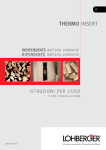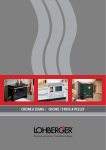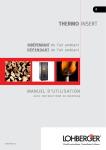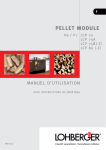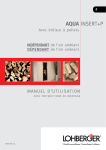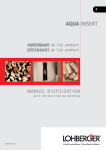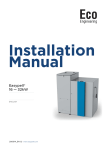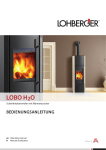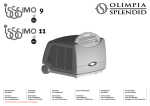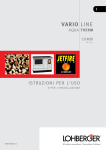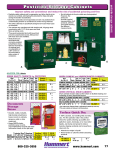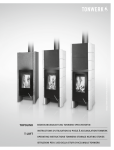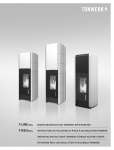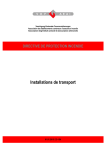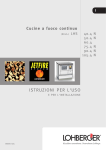Download AquA Insert+P - Lohberger Heiz
Transcript
GB Aqua Insert+P with pellet burner Independent of indoor air DEPENDENT on indoor air Operating Manual with installation instructions Issued November 2010 Table of contents 1. Safety instructions.........................................................3 Setting the heating output Key lock 16 17 2. Important instructions prior to installation and start-up...................................................................4 22. Main menu..................................................................17 3. Transport / Unpacking / Inspection...............................5 23. Settings Menu.............................................................17 Clock time /Date 17 Automatic operation 18 Heating times 18 Key lock (function) 19 Service code 19 Reset19 Summer /Winter 20 4. Important standards / guidelines..................................5 5. Special notes.................................................................5 6. Design of the appliance / Dimensions...........................6 7. Modes of operation........................................................7 Operation with pellets Operation with firewood 7 7 24. Information menu........................................................20 Sensors20 Actuators21 Appliance /SW Version 21 Operating hours 21 8. Functional description...................................................7 9. Fuels..............................................................................8 Suitable fuels Unsuitable fuels Prohibited fuels 8 8 8 25. First start-up of pellet burner.......................................22 10. Chimney / Flue pipe connection...................................8 26. Heating operation with pellets....................................22 11. Air supply for combustion WITH dependence on indoor air (open-flued appliance).........................9 12. Air supply for combustion NOT dependent on indoor air (room-sealed appliance).......................10 Switching the appliance on Setting the heat output 27. Operation with firewood .............................................23 Manual lighting of firewood Lighting of firewood by means of pellet burner Adding firewood during heating with pellets 13. Safety clearances.........................................................11 Floor pad as a protection against flying sparks 11 14. External cladding – to be provided by the customer...11 Convection air outlet 11 15. Connection of the heating system................................12 Heat output to water Return flow temperature boost Thermal discharge safety valve 22 22 23 23 23 28. External Release / Remote control unit (to be provided by the customer) ..................................24 29. Switching the appliance off ........................................24 30. Maintenance /Cleaning display....................................24 12 12 12 Display Cleaning Display special cleaning Display maintenance 24 24 24 16. Electrical connection....................................................13 31. Maintenance / Cleaning...............................................25 17. Requirements for the room where the appliance is situated..................................................................13 32. Resetting safety temperature limiter...........................27 Load-bearing capacity of the floor Room temperature and ambient temperature / humidity 13 13 18. Operation.....................................................................14 Accessories supplied by the manufacturer Closing the heating door Adjustment of the air supply Air wash system Adjustment of the temperature valve 14 14 14 14 14 33. Troubleshooting...........................................................27 34. Error messages / Remedy – Operation with pellets....28 35. After-sales service / How to order spare parts...........29 36. Technical data..............................................................30 37. Type testing / Quality certification ..............................30 38. Appliance dimensions.................................................31 19. Start-up........................................................................15 39. Diagram of connections...............................................32 20. Operation of the pellet burner / Settings....................16 40. Operating panel language...........................................32 21. Menu - Top level..........................................................16 41. Menu - overview..........................................................33 To switch on the appliance To switch off the appliance 16 16 42. Warranty......................................................................34 SHORT INSTRUCTIONS.......................................................36 Explanation of symbols Important information in this manual is indicated by the following symbols: NOTE: Instructions for correct use of the stove. It is the operator’s responsibility to follow these instructions. CAUTION: This symbol refers to particularly important notes. DANGER: This symbol indicates important rules of conduct for avoiding injury or material damage. Page 2 Foreword With the purchase of the AquaInsert insert stove you have selected a highquality product made by LOHBERGER. Apart from the beautiful and timeless design, we attach great importance to a mature combustion technology, high-quality materials as well as excellent workmanship. Correct handling and proper care are a prerequisite for trouble-free operation and a long service life. Therefore please read the information in this operating manual carefully. With the above in mind, we are convinced that this appliance will give satisfactory service for many years. Your LOHBERGER Heiz + Kochgeräte Technologie GmbH Our contribution towards climate protection During combustion, wood only emits the same amount of CO2 that it previously held as a tree. It makes no difference whether the wood burns or rots in the forest. Thus heating with wood corresponds to the natural biological cycle. 1. Safety instructions Please read the information in this manual carefully before you install or start up your heating appliance for the first time. Seek the advice of the local qualified chimney sweep before installing the appliance. When installing the appliance, the technical regulations applicable at the installation site as well as country-specific regulations such as the applicable building regulations, local fire protection laws and/or additional regional regulations must be observed. We strongly recommend that the connection and the installation work (in the case of self-installation the final inspection and approval) are always carried out by a certified specialist. CAUTION! CHILDREN PLAYING! The appliance becomes very hot when in use, in particular the viewing window and the body. Make sure that children are never in the immediate vicinity of the appliance when it is in use. During installation and operation •• When installing the appliance, follow each of the instructions of the operating manual. •• Pay attention to the safety gaps when installing the appliance. •• Check the appliance for damage (e.g. glass items). •• Make sure that you never load more firewood than required for the rated heating output (approx. 1 to 2 kg). •• When adding more firewood, open the door slowly and first allow the flue gas to escape up the chimney. By doing this you prevent the flue gas from entering the room. •• Bear in mind that certain components of the appliance (filling door, handles, etc.) become hot when it is in operation and represent a burn hazard. •• Do not obstruct the appliance during heating as this could lead to an explosion. Page 3 2. Important instructions prior to installation and start-up Before connecting the appliance to the chimney, inform the local qualified chimney sweep. •• Please read the information in this manual carefully before you install or start up your appliance for the first time. •• Failure to do so causes the warranty to become null and void! •• Keep this operating manual in a safe place. Should it be lost, we will be happy to send you a new copy. You will find important information in it as regards safety, use, proper care and maintenance of the appliance, so that you can enjoy your appliance for a long time. •• If there are any queries please contact our technical customer service. •• The stove must not be modified, except with original stove components, provided and tested by us or by work performed by our service technicians. CORRECT INSTALLATION AND START-UP The safety of the appliance can only be assured if it has been installed by a trained technician in compliance with the standards and regulations applicable at the place of installation. Make sure that the requirements of the applicable laws and standards as well as the local fire protection laws and building regulations are adhered to. Please consult the local qualified chimney sweep regarding the assessment of building and technical conditions. When operating the stove, make sure that there is an adequate supply of fresh air in the room where the appliance is located. An air exchange of at least 0.8 times per hour by means of a permanent and secure ventilation of the room must be ensured. If the windows and doors are tightly sealed or if other appliances such as extractor hoods, tumble driers, ventilators etc. draw air from the room where the appliance is located, it may be necessary to provide fresh combustion air from outside. The inlet apertures for combustion air must not be closed. For the first 2 to 3 days run the stove with a low output. During the first few days of operation expansion cracks may form in the fireclay-cladding. However, this does not impair the functioning of the appliance. PROPER OPERATION Proper operation, in compliance with the installation instructions and with the operating manual as well as with the instructions regarding safety and environmental protection. The proper dissipation of the heat output to the hot water system must be ensured (radiator / reservoir). Bear in mind that the appliance is not childproof (doors, etc.) and therefore it must not be operated by children or other people who are not authorized or trained. If the appliance is not installed properly and if the instructions (as stated in the technical documentation and operating manual) regarding the start-up and operation of the appliance are not followed, all warranty claims will become null and void. CAUTION: The chimney may have become obstructed when the stove is heated up again after it has been out of use for an extended period of time. Before re-starting the stove, have the chimney inspected by a specialist (chimney sweep). Only use suitable fuels by choosing environmentally-sustainable, high-quality and dry fuels (see Fuels). CHIMNEY REQUIREMENTS FOR HEATING SYSTEMS Before starting-up the appliance for the first time, the local qualified chimney sweep has to certify the suitability and readiness for operation of new or existing chimneys by a declaration of conformity. The owner has to ensure that the chimney is free from obstructions (no coverings or blockages). Ensure that there is adequate ventilation (sufficient fresh air) in the stove room. Please point out existing faults and /or alterations with regard to the chimney and the heating system. Due to low exhaust gas temperatures when the seasons change the chimney must be leak-free and humidityresistant. Make sure that flue and exhaust gas can escape freely to the outside. REGULAR CLEANING AND MAINTENANCE In order to ensure the functionality and efficiency of the appliance, regular maintenance and cleaning work must be carried out on every fireplace and all the connected system components (e.g. chimney, etc.). Please observe the instructions regarding maintenance and cleaning in this operating manual. Your chimney sweep will also be happy to clean the fireplace. Only clean and properly adjusted appliances work efficiently. Only install original spare parts provided by your local specialist dealer or by our company. Parts that are subject to wear and tear (e.g. seals), components exposed to high thermal stress (fireclay, cast-iron parts) or broken stove parts should be replaced or exchanged as soon as possible. Correct procedure in the event of chimney fires: Call the fire brigade via the emergency phone number. If the fireplace, connecting duct and chimney are not regularly cleaned or if unsuitable fuels are burned, the deposits may ignite, causing a chimney fire. Keep the stove doors closed and turn the air regulators to position „0“. Move away combustible components from the chimney. UNDER NO CIRCUMSTANCES should you attempt to extinguish the chimney fire by applying water. The suddenly developing steam pressure is so high that the chimney could burst. Page 4 3. Transport / Unpacking / Inspection Report visible faults to the supplier immediately. Later claims for damages cannot be entertained. The packaging of your appliances provides good protection against damage in transit. Nevertheless, damage to the appliance and fittings cannot be entirely excluded. Therefore carefully check the appliance for completeness and possible damage in transit after unpacking. 4. Important standards / guidelines When installing and starting-up the appliance, observe the local fire protection laws and building regulations as well as the following standards /regulations: ÖNORM (Austrian Standard) M7550 Central heating boiler up to 100 °C: definitions, requirements, tests, marking of conformity ÖNORM (Austrian Standard) M7510/1 Regulations for the inspection of central heating systems. ÖNORM (Austrian Standard) M7510/2 Guidelines for the inspection of central heating systems; standard values. ÖNORM (Austrian Standard) B8130 Safety devices. ÖNORM (Austrian Standard) B8131 Closed water heating systems; safety requirements. ÖNORM (Austrian Standard) B8133 Safety requirements for water heating systems. DIN 4751 Part 1 Safety devices for heating systems with flow temperatures of up to 110°C (120°C in preparation) DIN 4751 Part 2 Safety devices for heating systems with flow temperatures of up to 110°C (120°C in preparation); open and closed water heating systems up to 349 kW (300000 kcal/h) with thermostatic safety device. DIN 4751 Part 4 Safety devices for heating systems with flow temperatures of up to 120°C; closed water heating system with static heights exceeding 15 m or rated heat output over 350 kW. DIN 1988: Drinking water supply systems on building sites (technical requirements). ÖNORM (Austrian Standard) EN3035 Boiler for solid fuels, charged manually and automatically up to 300 kW. Definitions, requirements, testing and marking of conformity ÖNORM (Austrian Standard) M7135 Densified wood made of untreated wood or bark – wood pellets und briquettes. ÖNORM (Austrian Standard) M7136 Densified wood made of untreated wood – wood pellets – quality assurance for transport and storage logistics. ÖNORM (Austrian Standard) M7137 Densified wood made of untreated wood – wood pellets – Requirements for the customer’s pellet storage room. TRVB H118 Technical specifications regarding preventive fire protection for automatic wood-fired heating systems. 5. Special notes •• The appliance connections for the flue tube and the combustion air must not be altered. Make sure that the combustion air duct and the exhaust duct are free of obstructions before starting up and during operation of the appliance! RISK OF BURNS! •• When operating the appliance, please use the supplied protective gloves and the grate lifter. FIRE HAZARD! •• To prevent heat build-up, make sure that the convection air outlets are not closed. •• Keep the firebox door closed at all times. Avoid overheating the stove. The warranty does not cover any resulting damage. Page 5 6. Design of the appliance / Dimensions 23 1 2 4 24 5 6 25 19 26 7 8 9 10 20 27 21 28 29 30 11 12 13 31 32 14 15 16 17 1 Combustion air inlet pipe 100 mm oval 2 Exhaust gas pipe connection dia. 120 mm 3 Inspection door (with convection air outlets) 4 Cover cleaning opening 5 Thermal discharge safety valve 6 Upper maintenance door 7 Firebox door 8 Combustion chamber lining 9 Cast-iron grate, ash drawer underneath 10 Combustion air slider (primary air) 11 Door lock 12 Door handle (self-locking) 13 Lower maintenance door (with convection air outlets) 14 15 34 38 35 39 36 40 37 41 (RL) 21 Pellet burner door 23 Induced draught fan 24 Combustion air supply. pellet burner 25 Flow connection line Nameplate 26 Hopper cover Pump assembly with return flow temperature boost 27 Hopper 28 Rotary valve 16 Screen 29 Supply air connection pellet burner 17 Pellet burner ash drawer 30 Conveying system motor 19 Hopper safety guard 31 Grate motor 20 Pellet burner control panel 32 Safety temperature limiter “STB” Page 6 33 3 (VL) 33 Pellet burner main circuit board 34 Connections of thermal discharge safety valves 35 Servo-motor of combustion air throttle valve 36 Circulating pump 37 Heating connection (return flow) 38 Flow connection line 39 Safety valve with manometer 40 Mixing valve for return flow temperature boost 41 Heating connection (flow) 7. Modes of operation This appliance can be operated in two different modes: operation with pellets or with firewood. Operation with pellets The appliance is controlled with the use of preset control variables. In addition to heating the room where the appliance is located, hot water is generated by the integrated heating element. The heat is transferred to the heating system (reservoir, heating circuit, etc.). Operation with firewood In addition to the operation with pellets, the appliance can also be conventionally operated with firewood. The basic functions of heating up and operating the appliance are comparable to those of a normal wood burning stove. It is also possible to ignite the firewood automatically by means of the pellet burner. Just load the combustion chamber with firewood and turn on the pellet burner. If firewood is added to the combustion chamber while the appliance is running on pellets, it recognises this and changes automatically to OPERATION WITH FIREWOOD. •• Please note that operation of the boiler with the controller is only possible during operation with pellets. •• When burning firewood, the appliance must also be connected to the mains electricity supply to avoid damage to appliance components. 8. Functional description The wood-burning appliance AquaInsert with integrated pellet burner was specifically designed for burning firewood (logs) or wood pellets. The appliance can be used for heating the room where the appliance is installed. In addition, hot water is generated by means of the integrated heating element. The heat is transferred to the heating system by this means – if the appliance is used in combination with a solar energy system the heat will be transferred to a storage tank. The stove body, viewing window, etc. give off radiant heat. For heating, switch the appliance on; it regulates according to the temperature setting of the boiler when operating with pellets. The temperature setpoint of the boiler can be influenced by the setting SUMMER MODE /WINTER MODE. In addition, the output of the appliance can be affected by the setting of the output levels. Once the boiler has reached the set temperature, the selected output level applies an upper limit to the control range of the pellet burner. Switching the appliance on and off can be automated by the integrated programmer with a weekly programme or by means of a remote control unit in the room. On start-up, whether automated or manual, the comb grate is cleaned automatically. The wood pellets are then transported to the combustion chamber via a screw feeder (with integrated rotary valve to inhibit burn back) and electrically ignited. The screw feed automatically feeds more pellets. The oxygen required for combustion is supplied to the combustion chamber in a controlled flow. The combustion gases completely burn out in the combustion chamber of the pellet module and in the downstream combustion chamber for the firewood. The heat is emitted via the surface of the heat exchanger and the external surfaces of the appliance. An induced draught fan, corresponding to the amount of fuel and the combustion air required, provides a stable negative pressure in the appliance and ensures the safe evacuation of the flue gases to the chimney. Page 7 9. Fuels Suitable fuels WOOD PELLETS The wood pellets used (Figure 1) must comply with Austrian standard ÖNORM M7135 or DIN Plus. Diameter 6 mm, length max. 30 mm. Storage of wood pellets Pellets are supplied with a maximum moisture content of 10 % (standardscompliant). During transport and when storing pellets, they must be kept dry. The storage location must be dry and free from contamination. Figure 1 FIREWOOD (LOGS) Firewood (Figure 2) should have a moisture content of approx. 20 % of the dry weight, a length of 1/3 m and should be split into small pieces. This way, the firewood quickly catches fire and produces a higher heat output than the same volume of large logs. Spruce wood, fir wood or alder wood should be allowed to dry out for at least 2 years, hardwood as long as 3 years (under a roofed shelter). Figure 2 water content % calorific value kWh/kg green wood 50 ~2,3 stored for one winter 40 ~2,7 stored for one summer 18-25 ~3,4 air dried 15-20 ~4,2 Storage of wood Table 1 The effect of the water content in wood on the calorific value is shown in Table 1: Unsuitable fuels Moist wood, bark waste, sawdust, fine wood chips, brushwood, wood-wool, wood shavings. Use paper only in small amounts to kindle a fire. The burning of such fuels results in significant pollutant emissions, large amounts of ash, and the heat output is comparatively low. Prohibited fuels Surface-treated wood (veneered, painted, impregnated, etc.), particle board, all types of household waste (packaging waste), plastic materials, newspapers, rubber, leather, textiles, etc. Burning these materials is harmful to the environment and is therefore prohibiFailure to observe these instructions will invalidate any warranty! ted by law. Furthermore, damage to the appliance and the chimney can occur. Furthermore the combustion of coal and similar fuels is not permitted. The appliance has not been tested for use with these fuels; therefore damage to the appliance cannot be ruled out and is not covered by warranty. 10. Chimney / Flue pipe connection The appliance must not be connected to a shared flue system •• For safe operation of the appliance an effective chimney height of at least 5 m (from the flue connection to the chimney outlet) is recommended. •• For further information as regards the necessary minimum discharge pressure see the technical details on page 30, in our brochures and on the nameplate. •• Please have the minimum discharge pressure checked by the local chimney sweep! Flue pipe connection The flue pipe is the connection between the insert stove and the chimney. When installing the flue, please note the following instructions: •• The AQUA INSERT requires a 120 mm flue pipe. •• The connection between the insert stove and the chimney must be strong and leak-proof. In particular the connection to the masonry of the chimney must be durable and tight. •• Make sure that the connecting piece can be cleaned (cleaning opening). •• The diameter of the flue pipe must not decrease towards the chimney. Page 8 •• The flue pipe must not project into the chimney. •• Vertically positioned flue pipes must not exceed a length of 125 cm if they are not insulated. •• Horizontal pipe sections must not exceed a length of 100 cm. •• The flue pipe must not descend towards the chimney, but must incline slightly upward. The exhaust system must be inspected by the local qualified chimney sweep before starting to use the appliance. Chimney flue connection independent of indoor air (room-sealed appliance) If the appliance is operated independently of indoor air, the following instructions are also to be observed: •• The chimney flue must be sealed at the pipe connection by means of a temperature resistant sealant. •• The flue pipe must have a gas-proof connection to the chimney and must be sealed by means of an appropriate rope seal and a temperature resistant sealant (e.g. heat-resistant silicone). The total length of the connecting pipe between appliance and chimney should not exceed 1.5 m. 11. Air supply for combustion WITH dependence on indoor air exhaust gas (open-flued appliance) Air supply for combustion via the room where the appliance is located air intake convection air outlet air intake / convection air outlet Figure 3 exhaust gas air intake convection air outlet The air required for combustion is drawn from the room where the appliance is located. The room must be periodically ventilated, especially in well sealed buildings. Therefore provide sufficient changes of air in the room where the appliance is located. For rooms exceeding a volume of 50 m³, we recommend exchanging 1.5 times the volume of air per hour. For smaller rooms the rate of air exchange should be increased. If there are additional heating appliances in the same room, make sure that the air inlets can supply sufficient air for combustion for the operation of all appliances. Only if certain conditions are fulfilled it is permissible to operate open-flued fireplaces in combination with ventilation systems etc. For further information seek the advice of the manufacturer of your ventilation system. Negative pressures in the room where the appliance is located (e.g. through ventilation systems, extractor hoods, etc.) may impair the functioning of the fireplace and its safety system and are therefore not permissible. Please consult the local qualified chimney sweep and observe the local fire protection laws as well as the standards DIN 18896 (technical standards for the installation and the operation of fireplaces for solid fuels). Operate extractor hoods only with re-circulated air operation! With ducted extractor hoods, an adequate supply of air must be ensured by means of separate safety equipment (e.g. contact switches on the windows, negativepressure monitoring). Air supply for combustion via the room where the appliance is located (Figure 3) •• The air for combustion is pre-heated. •• It is necessary to ventilate the room at regular intervals or to provide a permanent opening for ventilation to the outside. convection air outlet Outdoor air supply for combustion (Figure 4) •• The air for combustion is only slightly pre-heated! •• Max. length 4 m with 3 bends. Figure 4 Page 9 12. Air supply for combustion NOT dependent on indoor exhaust gas (room-sealed appliance) The air for combustion is entirely supplied to the combustion chamber via a supply air pipe of 100 mm diameter (to be provided by the customer). air intake convection air outlet The oval-shaped pipe connection for the combustion air system is located on the cover plate behind the flue gas connection. The tight pipe connections are run directly to the outside or they are connected to an appropriate air-flue gas system. It is also feasible to extract the air from a room that is independently supplied with outdoor air (e.g. cellar). For the supply air duct provided by the customer, leak-proof pipes (e.g. steel pipes to DIN 24145 with flexible, non-combustible aluminium hose at the pipe connections) with at least 100 mm diameter, max. 3 bends and a permissible total length of 4 m are to be used. For greater lengths and more than 3 bends it is necessary to do a calculation. To facilitate the inspection and cleaning of the air supply duct, appropriate inspection doors must be provided. convection air outlet Figure 5 exhaust gas convection air outlet convection air outlet air intake Figure 6 exhaust gas convection air outlet The entire supply air duct must be air-tight. With special pipe systems a calculation of the cross sectional area of the chimney according to EN 13384-1 is required, taking into consideration the air supply duct. We recommend setting the ventilation system to a maximum negative pressure of 4 Pascal. Please note! •• A prerequisite for the connection of fireplaces used in combination with domestic ventilation systems is that the approval of the local qualified chimney sweep is obtained! •• It is not permitted to install cut-off devices in the supply air duct (dampers, sliders, etc.). To prevent air from permanently flowing through the appliance when it is not in use, close the sliding door at the appliance. •• Make sure that the outdoor air inlet is protected against blockage by means of a protective grating. We recommend a mesh size of 10 mm. •• For the supply air duct to the combustion air connecting piece it is best to use a non-combustible, flexible aluminium hose. •• The supply air duct must be insulated to avoid condensation and must be protected against wind. •• The air duct must be at least 100 mm in diameter. If rectangular pipes are employed, an appropriate cross section must be maintained. •• According to the regulations for chimney sweeping and inspection ventilation systems must be checked for blockages once a year by the local qualified chimney sweep. To facilitate this, appropriate inspection doors should be provided. Please consult your local qualified chimney sweep regarding this matter. •• Negative pressures in the room where the appliance is located are not permissible. Therefore the applicable technical guidelines for the use of appliances in combination with systems for ventilation and air conditioning (e.g. ventilation systems, extractor hoods, pneumatic conveyor systems, etc.) are to be adhered to. •• According to the assessment criteria of the DIBT in Berlin and the DIN 18160 standards, fireplaces with an external supply of air for combustion are only allowed if only one appliance is connected to the chimney. Outdoor air supply for combustion (Figure 5) •• The air for combustion is only slightly pre-heated! •• Max. length 4 m with 3 bends. Air supply for combustion via pipe line through a basement room (Figure 6) convection air outlet Air supply for combustion through a basement (Figure 7) air intake Figure 7 Page 10 •• The air for combustion is pre-heated. •• The air supply in the basement room can be easily implemented. •• Max. length 4 m with 3 bends. •• The air for combustion is pre-heated. •• The basement room must be excluded from the ventilation system of the dwelling and must be open to the outside. •• Avoid accumulation of dust and moisture. rear wall 13. Safety clearances The following safety clearances to combustible items (movable wooden walls, furniture, furnishing fabric, etc.) must be maintained: rear wall Rückwand Minimum distance flue pipe to ceiling:____________________240 mm Minimum cross section for convection air:__________________103 cm2 (if the convection air outlet is provided by the customer) Minimum clearance appliance body to combustible materials rear and sides:________________________________________150 mm B:\Entwicklung HH\-- Laufende Projekte\Heizeinsatz Fa. Plewa\Prüfungen\TÜV\Dokumente und Zeichnungen für Aqua Insert Zeichnungsprüfung\Zeichnungen-Bilder für Bedienungsanleitung\Baugruppe Sicherheitsabstand 80 0 Aqua Insert Clearance between combustible materials and convection air outlets:__________________________________150 mm 90° Strahlungsbereich area of heat radiation Within the area of heat radiation (Figure 8), the minimum clearance of 800 mm from the front of the combustion chamber opening to combustible components must be maintained. Figure 8 Floor pad as a protection against flying sparks Biegemaul 30 ZUSCHNITTMAß SONSTIGE ZEICHNUNGSINFOS: FERTIGMAß ABMESSUNGEN IN MILLIMETER MATERIAL FÜR DIESE ZEICHNUNG BEHALNTEN WIR UNS ALLE RECHTE VOR, SIE DARF OHNE UNSERE VORHERIGE SCHRIFTLICHE ROHTEILNUMMER ZUSTIMMUNG WEDER VERVIELFÄLTIGT NOCH SONST WIE BENÜTZT, NOCH DRITTEN ZUGÄNGLICH PRG.NR. GEMACHT WERDEN! mm 30 TOLERANZEN: LINEAR: DIN ISO 2768 T1 -mWINKEL: DIN ISO 2768 T2 -H- NAME DATUM GEZEICHN. LOHBERGER With combustible floors (timber flooring, synthetic materials, fitted carpet, etc.), the use of a floor pad made of safety glass or similar non-combustible materials is recommended According to fire protection laws, the minimum size (measurements in cm) for Heiz + Kochgeräte thisGmbH pad as shown in Figure 9 must be observed. Technologie BENENNUNG GEPRÜFT FREIGABE BESCHREIBUNG ARTIKELNUMMER OBERFLÄCHE 30 FORMAT ZEICHNUNGSNUMMER A4 501:20 MAßST.: protection against flying sparks GEWICHT: kg REV. BLATT 1 VON 2 Figure 9 14. External cladding – to be provided by the customer The minimum wall thickness of the external cladding (to be provided by the customer) of the Aqua Insert+P must be 20 mm. It must consist of standard, non-combustible insulation material such as for instance Ytong. Under no circumstances does Lohberger assume liability for the installation of the appliance. The HVAC installer conducting the inspections for fire safety shall bear the responsibility. Convection air outlet The convection air outlets must be designed in such a way that they cannot become blocked. A blockage can lead to excessive heat build-up and as a consequence the appliance will overheat. Figure 10 The supplied door for the convection air outlet must not be installed more than 50 cm above the top edge of the appliance (measurement at the top of the front of the appliance) so that a safe heat output through convection can be ensured (Figure 10). Page 11 15. Connection of the heating system The connection to the heating appliance as well as the start-up may only be performed by a certified HVAC installer. Provide a drain cock in the bottom area of the water circulation. The boiler is suitable and permissible as a heat generating device for hot-water heating systems with a flow temperature of up to 95° C and a maximum allowable working pressure of 3 bar. The insert stove must be installed following the instructions of this operating manual and in conformance with the applicable national and European standards as well as the regional regulations. Further points to be observed: •• Heating room guidelines •• State building regulations •• Local building regulations •• Industrial regulations and local fire protection laws •• Environmental laws •• Regulations of the local power supply company. Upon completion of the connection work a test run must be carried out during which all control and safety devices are adjusted and checked for correct functioning. Heat output to water The heat requirement during operation must exceed 1,6 kW. If the demand or heat supplied is lower the built-in safety devices would be activated and/or the appliance would be shut down. Return flow temperature boost Operating temperatures that are too low (flow and return flow temperatures that are too low) will reduce the service life of the boiler significantly. For this reason a return flow temperature boost with safety valve is pre-installed in the appliance. Thermal discharge safety valve The heat exchanger serves to protect the boiler from overheating when the pump is stationary and must not be used to provide domestic hot water. The safety mechanisms must still be accessible after the installation. The drain must be visible for checking the thermal discharge safety valve for proper functioning, therefore use the drain funnel. At least once a year the thermal safety valve must be checked for correct operation. To do this, press the red cap against the valve and water must flow into the drain funnel. Should the thermal discharge safety valve drip, the seal and valve seat must be cleaned. The calcification state of the safety devices must also be checked at least once a year. Use the built-in thermal discharge safety valve WATTS STS 20 according to DIN 3440 or DIN EN 14597. Trigger point 95°C, water flow rate at least 2,000 kg/h. Maintain the sensor length of 140 mm in compliance with the length of immersion sleeves of other types. The clearance of the supply and discharge safety valve of the safety heat exchanger must not be less than its nominal connecting width. There must be no manual shut-off in the supply line and the drain line must be free of obstructions. For further details as regards connecting the heating system please refer to the enclosed installation instructions. Page 12 16. Electrical connection •• Before performing any work on the appliance, the appliance must be disconnected from the mains supply (Emergency-STOP). •• Electrical connection work on the appliance must be performed by certified specialists according to the applicable technical rules, in particular the VDE guidelines (German Electrical Engineering Association) and the ÖVE guidelines (Austrian Electrical Engineering Association). We do not assume liability for damage to the appliance resulting from improper connection work; in such a case the warranty becomes null and void. •• All electric connecting cables from and to the appliance must be kept away from hot surfaces of the appliance and of the flue pipe. Do not lay the cable over sharp edges. •• The appliance is designed to operate only from a 230 V AC/ 50 Hz supply. Voltage fluctuations of 15 % to +10 % are permissible. If possible connect the supplied power cord to the mains supply prior to installing the appliance. •• The connection is done with a 3-pole power cord (supplied with the appliance). •• A protective earth conductor is mandatory. •• When connecting the appliance by means of a plug to a socket, pay attention to the appropriate polarity (if necessary use a mains plug with anti-rotation protection) because the appliance must be connected with the correct phase sequence. •• The main fuse is a built-in glass cartridge fuse 5x20 2.5 AT with ceramic body. The fuse is located on the main board at the front of the appliance (inside). •• An emergency STOP switch or an individual safety device must be installed into the main distribution (for maintenance work, etc.). We strongly recommend installing a smoke or fire detector that interrupts the power supply of the appliance in an emergency. 17. Requirements for the room where the appliance is situated Load-bearing capacity of the floor Prior to installing the appliance, make sure that the substructure of the floor is suitable for the weight of the appliance. Ensure a level and vibration-free positioning of the appliance. Room temperature and ambient temperature / humidity The appliance can be operated in dwellings with normal air humidity and room temperatures of + 5 °C to + 20 °C. For room temperatures below 5°C, the water circuit must have an appropriate anti-freeze. The appliance is not protected against water spray and must not be installed in wet rooms. Page 13 18. Operation Accessories supplied by the manufacturer To ensure a safe operation of the appliance, it comes with protective gloves, a grate lifter and a cleaning brush. Closing the heating door The door of the AquaInsert is self-closing and self-locking. To open the heating door, press the integrated release button fully while pulling on the door handle. When closing the heating door make sure that it engages with an audible click. Check: It must not be possible to open the door simply by pulling on the door handle. 0 1 Adjustment of the air supply Figure 11 The air supply required for combustion, which is taken from the bottom through the grate into the combustion chamber, is adjusted by using the air slider in the front panel (Figure 11). This enables the required temperature in the combustion chamber to be reached faster during the initial heating-up phase. Position 0: The slider is closed, no primary air is supplied. Position 1: The slider is opened, maximum supply of air, especially necessary during the heating-up phase. reservoir The supply of secondary air (combustion air flowing from the top, over the fuel) results in combustion that is matched to the fuel being used, resulting in lowpollution emissions. The secondary air intake cannot be adjusted and is pre-set for optimal combustion at the rated heat output. Air wash system The air wash system is very important both for the cleanness of the viewing window and for providing secondary air that gives low-pollution combustion. The air “washes down” across the glass front, flowing towards the combustion chamber where it contributes to the combustion. This gives the best possible cleanness of the window. bleed-off valve closed (adjusting knob screwed in) solid fuel boiler pump speed / position 3 Figure 12 reservoir Please note the following factors with regard to a clean window: 1. Optimum chimney draught For the air supply the chimney draught and the length of the supply line play a decisive role. Certain weather conditions, especially between seasons, can have a detrimental impact on the chimney draught. 2. Dry, suitable fuel Use only dry wood (residual moisture max. 10-15 %). Resinous wood has a negative effect on the cleanness of the window. Do not burn painted, impregnated or other similarly treated wood. Do not burn bark, particle board or other waste. 3. Correct operation Remove ash at regular intervals, however, at the latest when the ash heap has reached the air outlets in the ash pan. Only add the amount of fuel that is necessary to generate the required heat. 4. Correct air supply setting Fully open the combustion air supply. If dirt still forms on the glass, it can be removed with a special glass cleaner for chimney and oven windows when the appliance has cooled down. For further details see MAINTENANCE AND CARE. Adjustment of the temperature valve bleed-off valve open (adjusting knob screed out) solid fuel boiler pump speed / position 2 Figure 13 Page 14 The temperature valve with bleed-off valve can be integrated into a system with a reservoir. Once the boiler circuit has reached the opening temperature of 55°C, the output of the pump can be used for filling the reservoir (Fig. 12). If the temperature valve is integrated into a system with a distributor, the pump applies a positive pressure to the entire system. If the bleed-off valve of the temperature valve is open, this pressure can be released via the valve. By doing so an unintended incorrect circulation can be prevented which could result for instance in sending water into the domestic hot water storage tank (Figure 13). 19. Start-up Warning Before operating the appliance with logs, check the fill state of the reservoir. When the reservoir is full the heat output to the water cannot be dissipated or can only be dissipated for a short time. This can lead to malfunctioning or the thermal discharge safety valve may be triggered. After completion of the assembly and connecting work and prior to the first start-up, a few actions are still required: •• Open the door of the combustion chamber and remove appliance accessories and transportation safety devices. •• Before each start-up, make sure that it is ready for use (water level, water pressure, temperature, controls, safety devices etc.) After you have familiarised yourself with the operating procedures for the stove, the first start-up can begin. Heating the appliance for the first time The outer finish of the AquaInsert+P is high-quality, air-drying lacquer which gives off virtually no fumes or odour on first use if it is first allowed to cure sufficiently (at room temperature). If the appliance is used before then, it can produce smoke or odour for a short time. Please provide good ventilation for the room where the appliance is located. Heating up •• Open firebox door and put the primary air slider in position 1 •• Place 2-3 small pieces of firewood on the grate •• Spread wood wool or newspaper over them and place 2 pieces of split logs on top, light the fire and then place one piece of firewood centrally on top •• Close the firebox door and let the wood burn vigorously. •• Add more fuel •• After the heating up phase is completed, add more fuel according to Table 2. •• Adjust the primary air depending on the type of fuel and the heating demand. To prevent the escape of flue gases, keep the door of the combustion chamber closed at all times except when lighting a fire, re-fuelling or removing ashes Do not throw the pieces of wood into the combustion chamber as this may cause damage to the firebox plates. Adding Fuel When adding fuel we recommend short intervals (every 40 – 50 minutes) and small amounts. This way the rated heat output is reached with low pollutant emissions and a good level of efficiency. Air supply settings Type of fuel Rated load - Primary air Spruce wood, air-dried 1 (fully open) Beech wood, air-dried 1 (fully open) Table 2 Adding of fuel 2-3 pieces of wood, approx. 2.4 kg Burn-up time approx. 60 min. Heat output Rated heat output Table 3 Table 2 shows the recommended settings for the air supply (after the operating temperature has been reached). The indicated values for the settings are approximate values. The setting of the air slider that suits the heating requirements of the room is established by experimenting. Guideline values for the fuel quantity and burning time The following table 3 shows the recommended amount of fuel to be added for the rated heat output. If this amount is exceeded, overheating and consequent damage can result. Heating When only embers are left on the grate, new fuel should be added evenly over the whole grate. To do so, spread the embers evenly over the grate and then more fuel can be placed on top. Heating in between seasons When outdoor temperatures are above 15°C, it may occur that due to low chimney draught the fire does not burn very well. This will result in an increased build-up of soot in the flue passages of the appliance and in the chimney. To reduce the build-up of soot when heating in between seasons, increase the primary air supply, poke the fire more often and add fuel more frequently (smaller pieces of wood). Page 15 20. Operation of the pellet burner / Settings Display (illuminated) BUTTON “UP“ To select the desired menu item in all sub-levels To activate the key lock (only with activated key lock function) simultaneously press the buttons UP and DOWN in the top level To switch on the functions in the adjustment levels To increase values in the adjustment levels Display options top level: Appliance status Clock time Operating status Output level Button „OK“ To enter all sub-levels of the menu, starting at the top level. To confirm the selected sub-levels of the menu. To confirm the set values and to switch from one adjustment point to the next in the adjustment levels To acknowledge error messages by pressing and holding the button (approx. 2 seconds) Appliance OFF 13:45 Burner OFF ----> ||||| ||||| ||||| ||Output<| ||| ||||| |||| OK Button “ON / OFF“ To switch the appliance on and off in the top level. Figure 14 Button ”LEFT“ To reduce the output in the top level. To switch from one adjustment point to the previous in the adjustment levels Go back one menu level. Button „DOWN“ To select the desired menu item in all sub-levels To activate the key lock (only with activated key lock function) by simultaneously pressing the buttons UP and DOWN in the top level. To switch off functions in the adjustment levels. To reduce the values in the adjustment levels Button „RIGHT“ To increase output in the top level. To switch from one adjustment point to the next in all adjustment levels. 21. Menu - Top level Appliance OFF 13:45 Burner OFF ----> ||||| ||||| ||||| ||Output<| ||| ||||| |||| Figure 15 In the top level of the menu (Figure 15) the current appliance status is shown and the basic controls such as switching the appliance on/off, setting the heat output and activating the key lock are available. DISPLAYED INFORMATION Line 1 Current appliance status and current clock time Line 2 Current operating status, information and error messages. Line 3 Selected output level ILLUMINATION To switch on the display illumination, press any operating button; after approx. 30 seconds the illumination is turned off automatically. To switch on the appliance Press once in the top level of the menu. The display “Appliance ON” appears as well as the operating status: burner start-up. The appliance turns on. To switch off the appliance Press once in the top level of the menu. The display “Appliance OFF” appears as well as the operating status: burner OFF. The appliance shuts down. Setting the heating output To reduce the heating output, press in the top level of the menu. To increase the heating output, press in the top level of the menu. Adjustment range heating output: 3 - 10 for air heaters (P6) 5 - 10 for central heating appliances (P7, type designation -Z) Page 16 Key lock The key lock prevents an unintentional modification of the appliance settings (e.g. when cleaning the control panel, caused by children, etc.) and can be switched on or off if required. To switch on the key lock, press the buttons and at the same time. To switch off the key lock, press the buttons and at the same time. The key lock function is switched off when the appliance is delivered and can be activated in the menu SETTINGS --> See item Key lock (function). If the key lock is activated, it is still active when power returns after a failure. 22. Settings Menu To enter the main menu from the top level of the menu, press the OK button once. -- Main menu ->Settings < Information Factory level Figure 16 Settings Appliance settings Information Display /Information about the appliance and its components Factory level Detailed settings (service technician) 23. Settings Menu To access SETTINGS from the main menu, select the menu SETTINGS with or and press the OK button once (Figure 17). -- Main menu ->Settings < Information Factory level Figure 17 -- Settings ->Clock time/Date <| Automatic operation| Heating times |% Figure 18 Clock time /Date: To set clock time and date Automatic operation: To change between manual operation and operation with adjustable heating times. Heating times: Adjustment of heating times Key lock: To turn the key lock on/off Service code: For use by the service technician to reset the cleaning / maintenance interval. Reset: To reset all settings made by the customer. For central heating appliances: Summer/Winter: To change from summer to winter mode. Clock time /Date -- Settings ->Clock time/Date <| Automatic operation| Heating times |% Select the menu Time/Date in the menu Settings with the OK button once (Figure 19). Select sub-menu Clock time by pressing the buttons or or and press (Figure 20). Figure 19 -- Clock time/Date ->Clock time 13:46< Date 04/09/2009 Figure 20 Press Adjust Press Adjust Press OK button once; the display Hour flashes as required by pressing the buttons or OK button once: the set value is stored and the display Minute flashes by pressing the buttons or OK button once; the set value is stored -- Clock time/Date -- Select sub-menu Date by pressing the buttons Clock time 13:46 >Date 04/09/2009< Press OK button once; the display Day flashes Adjust by pressing the buttons or or (Figure 21) Figure 21 Page 17 Press Adjust Press Adjust Press Press OK 1button once; the set value is stored, the display Month flashes by pressing OK button by pressing OK button the buttons or once; the set value is stored and the display Year flashes the buttons or once, the set value is stored 3 times to return to the top level of the menu. Automatic operation Automatic operation determines whether the appliance is operated manually (standard setting OFF) or whether the internal clock is used for switching the appliance on and off. -- Settings -Clock time/Date | >Automatic operation<| Heating times |% Select the menu AUTOMATIC OPERATION in the menu Settings by pressing or (Figure 22) Figure 22 Press the OK button once. --Automatic operation-- The setting can be changed by pressing the buttons >Automatic operation OFF< Press the button or (Figure 23/24). 3 times to return to the top level of the menu. Figure 23 If the appliance is to be switched on or off by an external command, for instance from a room thermostat, a reservoir thermostat etc., AUTOMATIC OPERATION can be OFF or ON. However, if AUTOMATIC OPERATION is ON, an external command will only be acted on during the heating times that have been set. --Automatic operation->Automatic operation ON< Figure 24 For operation with a remote control unit the burner must be activated; in the top level of the menu “Appliance ON” must be displayed. Heating times Here you can select two heating periods for each individual weekday (MO, TU, WE …). If the same times are wanted for the whole week, the two heating periods can be selected with ALL. -- Settings -Clock time/Date | Automatic operation | >Heating times <|% CAUTION: The setting ALL will replace all settings of the individual weekdays Figure 25 -- Heating times -- Select the menu HEATING TIMES in the menu Settings by pressing the buttons or and press the OK button once (Figure 25). Select weekday by pressing the buttons or OK button and press once (Figure 26). >MO< WE FR SU TU TH SA ALL Select heating period (T1 /T2) by pressing the buttons or (Figure 27) Figure 26 Press OK button once; the display Turn-on time hour flashes --Heating times MO->T1 10:30 - 13:00< T2 13:30 - 17:00 Figure 27 or Adjust value by pressing the buttons Press the OK button once; the set value is stored, the display Turn-on time minute flashes Adjust value by pressing the buttons or Press OK button once; the set value is stored, the display Turn-off time hour flashes. --> For making the settings see turn-on time.. Press button Page 18 four times to return to the top level of the menu. Key lock (function) -- Settings -- Automatic operation |% To be able to use the key lock in the top level of the menu, the key lock function must be switched on. Heating times | >Key lock <|% Figure 28 -- Key lock -- Select the menu KEY LOCK in the menu Settings by pressing press the OK button once (Figure 28). or and The key lock function can be switched on/off by pressing the buttons (Figure 29/30). >Key lock OFF< Figure 29 -- Key lock -- Press button or three times to return to the top level of the menu. Now the key lock can be switched on/off in the top level of the menu by simultaneously pressing the buttons and . >Key lock ON< Figure 30 Servicecode To confirm cleaning work or maintenance work that has been performed on the appliance, a service code must be entered. This will reset the relevant internal operating-time clock. •• Cleaning work is due after 250 operating hours and this will be indicated in the top level of the menu by the display “APPLIANCE CLEANING”; confirmation with cleaning code 1234 -- Settings -Heating times |% Key lock | >Service code <|% •• Maintenance work is necessary after 2,000 operating hours and this will be shown in the top level of the menu by “APPLIANCE MAINTENANCE”, a confirmation by a service technician is required. Figure 31 -- Service code ->Service code ****< Figure 32 -- Service code -Code INCORRECT Figure 33 Select the menu SERVICE CODE in the menu Settings by pressing the buttons or and press OK button once (Figure 31). Press OK button once, the first digit flashes Adjust number by pressing the buttons or (Figure 32) Press OK button once; the next digit flashes. After entering the last digit, press the OK button once, if the correct service code has been entered, the message “Cleaning confirmed” or “Maintenance confirmed” appears in the text box. Press the OK button once, the operating-time clock for the maintenance interval will be reset (resetting not visible). If an incorrect service code was entered, the message Code INCORRECT appears in the text box (Figure 33). Press OK button once, repeat the steps for the entry of the service code and enter the correct service code. Press button twice to return to the top level of the menu. Reset In a reset all customer specific settings such as heating times etc. will be reset to the factory setting. -- Settings -Key lock |% Service code | >Reset <|% Select the menu RESET in the menu Settings by pressing the buttons and press or OK button once (Figure 34). Figure 34 -- Reset Press OK button once; a reset will be carried ou (Figure 35). -- The display returns to the menu Settings. Reset with OK Press the button twice to return to the top level of the menu. Figure 35 Page 19 Summer /Winter -- Settings -Service code |% Reset | >Summer/Winter <| To reduce the heat output in summer, the appliance can be adjusted from WINTER MODE to SUMMER MODE. This setting puts an upper limit on the adjustment range of the pellet burner. Figure 36 -- Summer/Winter -- •• Boiler set-point temperature WINTER 75 °C •• Boiler set-point temperature SUMMER 65 °C Select the menu SUMMER /WINTER in the menu Settings by pressing the buttons or and press the OK button once (Figure 36). >Winter mode < Figure 37 The setting can be changed by pressing the buttons Press button -- Summer/Winter -- or (Figure 37/38). three times to return to the top level of the menu. >Summer mode < Figure 38 24. Information menu To enter the menu INFORMATION from the main menu, select the menu INFOR- -- Main menu -Settings >Information < Factory level or MATION by pressing Figure 39 -- Information ->Sensors <| Actuators | System/SW-Version |% and press the OK button once (Figure 39). Sensors Passive appliance components such as sensors, etc. Actuators Active appliance components such as motors, blowers, etc. Appliance /SW Version Display of the pre-set appliance type and of the installed software version Operating hours Display of the total of operating hours as well as how many operating hours remain until the next maintenance of the appliance is due. Figure 40 Sensors Select the menu SENSORS in the menu Information by pressing the button -- Information ->Sensors <| Actuators | System/SW-Version |% or Figure 41 -- Sensors ->Door contact ON <| Grate contact ON | Release ON |% and press the OK button once (Figure 41) Paging through the menu items is possible by pressing the button (Figure 41-44). or ON /OFF (OFF = Door open) ON /OFF (OFF = Grate open) ON /OFF (OFF = No external command) Figure 42 -- Sensors -T Flame 38 |% T Exhaust 26 | >T Plug-in 24<|% Current flame temperature Current exhaust gas temperature Current discharge chute temperature Figure 43 -- Sensors -T Plug-in 24 |% T Boiler 29 | >Damper contact OFF<| Current boiler temperature ON /OFF (OFF = Operation with firewood) Figure 44 Press the button Page 20 three times to return to the top level of the menu. Actuators -- Information -Sensors | >Actuators <| Select the menu ACTUATORS in the menu Information by pressing the button or Appliance /SW Version |% Figure 45 -- Actuators ->Plug-in OFF <| Timing 0| Blower OFF |% Figure 46 -- Actuators -Speed 0 |% Grate motor OFF | >Ignition OFF<|% and press the OK button once (Figure 45). Paging through the menu items is possible by pressing the button (Figure 46-48). or ON /OFF (OFF = screw feed off ) Current value ON /OFF (OFF = Blower off ) Current value ON /OFF (OFF = Motor off ) ON /OFF (OFF = Ignition off ) Figure 47 -- Actuators -Ignition OFF |% Pump OFF | >Damper motor OFF<| ON /OFF (OFF = Pump off ) ON /OFF (OFF = Motor off ) Figure 48 Press button three times to return to the top level of the menu. Appliance /SW Version -- Information -Sensors | Actuators | Select the menu APPLIANCE /SW VERSION in the menu Information by pressing the button or and press the OK button once (Figure 49). >Appliance /SW Version<|% Figure 49 --Appliance /SW Version-- Appliance type Software version main circuit board Software version control panel P7/LCP75B/LCP80N SW VersionA 8.27 SW VersionD 1. 6 Figure 50 Press the button three times to return to the top level of the menu. Operating hours -- Information -Actuators |% Select the menu OPERATING HOURS in the menu Information by pressing the button or and press the OK button once (Figure 51). Appliance /SW Version | >Operating hours <|% Figure 51 --Operating hours -Total 0 Until maintenance 2000 Figure 52 Display of operating hours Display operating hours remaining until maintenance of the appliance is next due Press button three times to return to the top level of the menu. Page 21 25. First start-up of pellet burner •• Do not leave small children unattended in the immediate vicinity of the appliance: the equipment is not childproof. •• Prior to the first start-up check all connections of the appliance (chimney flue connection, power supply, etc.). •• The viewing window and door become very hot when the stove is in use (temperatures up to 300°C). Make sure that these parts are not touched when the appliance is in operation. •• Keep the firebox door closed at all times, even if the stove is not in use. •• Make sure that there are no objects in the combustion chamber and none in the pellet firebox. •• Only after the installation has been completed in compliance with the operating manual and installation instructions, is it permissible to load pellets into the hopper (at least 5 kg). General note – Surfaces Only high-quality air-drying paint is used which does not smell nor give off fumes when heated for the first time if it is allowed to dry completely (at room temperature). If the appliance is heated up before the finish has fully dried, an odour and fumes will be temporarily produced. Please ensure good ventilation of the room where the appliance is located. Loading the hopper Make sure that you use pellets approved to the Austrian Standards ÖNORM M7135/DIN 51731 – see imprint on the pellet bags or consult your pellet supplier. Open the lid of the hopper. To avoid raising dust, pour pellets slowly and not from too great a height. After feeding the pellets, close the lid and keep it closed during operation. 26. Heating operation with pellets The regulation is determined by the specified boiler set-point temperature (75°C or 65°C, see setting SUMMER MODE /WINTER MODE). If the set-point temperature of the boiler is exceeded by 10°C, the appliance shuts down automatically display Burner OFF - and only switches on again when the boiler temperature is 3 °C below the set-point. The appliance might resume operation automatically at any time, therefore please note the information in External Release /Remote control unit Switching the appliance on Appliance ON 13:45 Burner start-up ----> ||||| ||||| ||||| ||Output<| ||| ||||| |||| Figure 53 Press the button once in the top level of the menu. The display “Appliance ON” appears as well as the operating status burner start-up (Figure 53). The appliance switches on. Setting the heat output Appliance ON 13:45 Burner ON ----> ||||| ||||| ||||| ||Output<| ||| ||||| |||| Figure 54 Setting of the heating output in the top level of the menu (Figure 54) Reduce heat output by pressing the button Increase heat output by pressing the button . . Adjustment range of heat output: 3 - 10 for air heaters (P6) 5 - 10 for central heating appliances (P7, type designation –Z) If the heat output is not sufficient even when set at the highest level, the temperature can be increased by adding firewood. For operation with a remote control unit the burner must be activated; in the top level of the menu “Appliance ON” must be displayed. Page 22 27. Operation with firewood Manual lighting of firewood Appliance OFF 13:45 Burner OFF ----> ||||| ||||| ||||| ||Output<| ||| ||||| |||| Figure 55 •• Open heater door, lay 2 to 3 small pieces of firewood or wood-shavings on the grate •• Place 2 to 3 small logs on top of them and light them. •• Close heater door and allow the fire to burn brightly The display still shows Appliance OFF or Burner OFF (Figure 57). Lighting of firewood by means of pellet burner •• Open heater door, place 2 or three small pieces of firewood (beech wood) onto the grate (approx. 2.4 kg) •• Close heater door. Press the button Appliance ON 13:45 Burner start-up ----> ||||| ||||| ||||| ||Output<| ||| ||||| |||| Figure 56 Appliance ON 13:45 Operation with wood ----> ||||| ||||| ||||| ||Output<| ||| ||||| |||| Figure 57 once in the top level of the menu. The display Appliance ON and the operating status Burner start-up appear (Figure 58). Because of the increased output caused by the burning of firewood, the pellet burner switches to operation with firewood; the display shows the operating status Operation with firewood (Figure 59). If no further increase in the output is recognised while the stove is running on firewood, the appliance automatically returns to Operation with pellets if the appliance is ON. If the appliance continues to burn firewood, the pellet burner shuts down automatically. If no more firewood is added, the appliance automatically changes after a safety delay to heating operation with pellets according to the pre-set heating output. Adding firewood during heating with pellets If more firewood is loaded while the appliance is being heated with pellets, the appliance first switches to operation with firewood. The display Appliance ON as well as the operating status Operation with firewood appears (Figure 60). If the appliance is operated with a low heat output, the firewood may not be immediately recognised, which will delay the lighting of the firewood. Appliance ON 13:45 Operation with wood ----> ||||| ||||| ||||| ||Output<| ||| ||||| |||| If the appliance continues to burn firewood, the pellet burner shuts down automatically. If no more firewood is added, the appliance automatically changes, after a safety delay, to heating with pellets with the pre-set heating output. Figure 58 CAUTION: During operation with firewood, there is no automatic control of the output through the pellet stove control. Control of the output depends on the amount of fuel added. Only the heating circuit pump is switched on or off. Page 23 28. External Release / Remote control unit (to be provided by the customer) It is also possible to switch the pellet burner on or off by means of a remote control unit. The burner is released through a normally open contact on the main circuit board. Without a remote control unit this contact must be bridged (condition as supplied to the customer). The remote control unit is connected to the main circuit board to replace the bridge. No additional software activation is necessary. For operation with a remote control unit the burner needs to be activated, in the menu top level “Appliance ON” must appear. When the remote control unit switches on, the burner starts with the appropriate ignition programme, depending on the flame temperature. When the remote control unit switches off, the burner switches off automatically after a delay of 5 minutes and waits for the next command from the remote control unit. The appliance can switch on automatically at any time. Therefore we recommend installing a smoke or fire detector that makes a warning sound in an emergency and interrupts the power supply of the appliance. •• The appliance must be switched on (Appliance ON) and the desired heating output must be pre-set. •• If the remote control unit switches off, the burner continues to run for approx. 5 minutes •• Before starting the burner or operating the appliance with firewood, check the level in the reservoir. •• If the reservoir is full, the heat output to water cannot be dissipated or only be dissipated for a short time. This can lead to disturbances through the system constantly switching off in pellet operation and the thermal discharge safety valve may be triggered when the system runs on firewood. 29. Switching the appliance off Appliance OFF 13:45 Press the button once in the top level of the menu. The display Appliance OFF and the operating status Burner OFF appear (Figure 59). The appliance shuts down. Burner OFF ----> ||||| ||||| ||||| ||Output<| ||| ||||| |||| Figure 59 30. Maintenance /Cleaning display Appliance ON 13:45 APPLIANCE CLEANING ----> ||||| ||||| ||||| ||Output<| ||| ||||| |||| Figure 60 Display Cleaning The display APPLIANCE CLEANING appears after 250 operating hours (Figure 60). After the cleaning work has been performed, the display is reset by using the service code CLEANING and timing restarts for the next cleaning. For details how to reset the service code, please refer to the service code item on page 19. Display special cleaning Appliance ON 13:45 SPECIAL CLEANING ----> ||||| ||||| ||||| ||Output<| ||| ||||| |||| Figure 61 Appliance ON 13:45 APPLIANCE MAINTENANCE ----> ||||| ||||| ||||| ||Output<| ||| ||||| |||| Figure 62 The display SPECIAL CLEANING appears after several fault states have occurred in succession, such as NO PELLETS, NO IGNITION OR LOADING DOOR OPEN (Figure 61). This display indicates a possible problem caused by dust or dirt that has accumulated in the appliance. Remove deposits from the appliance, in particular from the pellet burner block, by means of the supplied cleaning brush. Then press and hold the OK button for two seconds to clear the displayed message. Display maintenance The display APPLIANCE MAINTENANCE appears after 2000 operating hours. A full service of the appliance is then necessary (Figure 62). The servicing must be carried out by a trained service technician. Please get in touch with your local dealer. This maintenance checks all installed components and ensures that they are working well. Once the maintenance work has been completed, the display will be reset by the service technician with the service code MAINTENANCE, and timing for the maintenance period restarts. We offer you the option of an annual maintenance contract. If you wish to take advantage of this service, please do not hesitate to contact the customer service department of LOHBERGER®. Page 24 31. Maintenance / Cleaning Allow the appliance to cool down before doing any cleaning work to avoid coming into contact with embers or hot components – RISK OF BURNS! Have your fireplace inspected by a specialist (customer service, chimney sweep) at regular intervals. Regular maintenance and care or cleaning of the appliance, the fuel gas ducts and the chimney are particularly important for the operational safety, efficiency and maintaining the value of the appliance. A thorough cleaning should be performed after each heating period and after a long period of non-use (see Important instructions, page 4). When used frequently or when using poor-quality fuels, correspondingly more often. •• Remove the grate and brush it. Clear out clogged grate slits. •• Clean combustion chamber walls and flue gas ducts with the ash shovel or with the cleaning brush. •• Remove ash pan and empty it. Sweep or vacuum the ash pan enclosure. •• Use the cleaning brush to sweep the heating gas ducts accessible after removing the cleaning cover. •• Check the sealing cords of the firebox door and of the cleaning cover; replace them if required. •• Clear the secondary air vents at the back wall of the firebox. •• When reinstalling the various appliance components (grate, cleaning cover, ash pan) ensure they are correctly positioned and function as required and / or that there are no leaks. Using the vacuum cleaner Allow the appliance to cool down completely and only use a vacuum cleaner with an “Ash Box” accessory – FIRE HAZARD The ash can still contain live embers: Dispose of the ash only into metal canisters! Cleaning of painted surfaces Wipe painted surfaces with a damp cloth; do not use abrasive. Do not use solvent-based cleaning agents (e.g. glass cleaner etc.). Latching Cleaning glass viewing window of combustion chamber Figure 63 To clean the glass viewing window use gentle cleaning agents (e.g. soapy water) and a soft cloth. Depending on the length of operation, the output of the appliance and the quality of the pellets, a light-brown to dark brown deposit can build up on the viewing window. This is a natural process when burning biomass and does not constitute a fault. To reduce the misting-up (even in case of continuous operation over several days), air “washes down” across the glass front (air wash system). Latching the firebox door Flame temperature sensor For ease of cleaning the combustion chamber, the door can be latched. To do this, fully open the firebox door and push the small tab towards the door hinge (Figure 63). Cleaning combustion chamber Clean the combustion chamber by means of the supplied cleaning tool. Remove deposits from the pellet burner block and from the flame temperature sensor by means of the supplied cleaning brush (Figure 64). The cleaning brush must be inserted as far as the grate of the pellet burner. Check: The handle of the cleaning brush should only protrude from the pellet burner block by a hand’s breadth. Deposits Figure 64 Page 25 Cleaning the heat exchanger seal baffles baffle plate Behind the upper maintenance door there is a cleaning aperture. The cover is attached to the body of the appliance by two wing nuts. Remove the baffle as well as the baffle plates (3 pcs.) to clean the surfaces of the heat exchanger. Check the seal for damage and if necessary replace it before screwing on again (Figure 65) Remove deposits from the surfaces of the heat exchanger as well as from the heat exchanger pipes using the supplied cleaning brush . (Figure 66) Cleaning heat exchanger (optional equipment) Easy cleaning of the heat exchanger tubes through built-in heat exchanger (Figure 67). Figure 65 The heat exchanger cleaning which is available as optional equipment can also be fitted at a later time. Combustion chamber ash pan cleaning brush CAUTION: The ash drawer may be hot Remember to empty the ash pan regularly and in good time (Figure 68). To do this, swivel the grate using the supplied grate lifter (1). Use the grate lifter to remove the ash pan towards the front (2+3) and empty it, and clean the ash chamber. Figure 66 The pile of ash must not obstruct the primary air vents in the ash pan. Pellet burner ash pan Open the door of the pellet extension and pull out the ash drawer (Figure 69). Empty the ash drawer and clean the ash chamber. CAUTION: The ash drawer may be hot control knob heat exchanger cleaning Figure 67 1 2 3 primary air vents Figure 68 Figure 69 Page 26 Grate If the air slits are very clogged by slag, crusts or other combustion residue, completely remove the grate and clean it (Figure 67). To do this, open the combustion chamber door and lift the grate with the grate lifter (1) and pull out towards the front. 32. Resetting safety temperature limiter If the maximum permissible boiler temperature of 95°C is exceeded, the safety temperature limiter (STB) is triggered and the error indication STB TRIGGERED appears on the display. Once the appliance has cooled down, the limiter must be reset manually (Figure 70): •• Open door of the pellet extension. •• Unscrew the black protective cap and press the red reset knob. •• Clear the error status by pressing the OK button. reset knob (red) Figure 70 33. Troubleshooting In the event of a fault (power failure, overload, etc.) turn the air regulator to position 0 and keep the combustion chamber door closed; do not add fuel. Open all shut-off devices in the heating system. If there is any damage or a fire hazard, leave the building immediately and call the fire brigade. Problem / Fault Smoke escaping during heating up or heating Temperature too low (stove fails to heat properly) Temperature too high (risk of overheating) Side walls of the combustion chamber are sooty Possible cause Solution Chimney still cold or stale air in the chimney. Light ball of paper in the stove and allow it to burn out. The fuel used is too smoky, moist or of poor quality: See FUELS on page 8. Heating gas flue or chimney excessively sooty or blocked: As soon as possible, thoroughly clean the stove and the connecting ducts; have the chimney swept. Weather-induced, stale air in the chimney See START-UP on page 15. Incorrect setting of air supply (too low, not suitable for the fuel being used) See AIR SUPPLY SETTING on page 15. Wrong, too damp or inferior fuel is being used: See FUELS on page 8. Weather-induced, stale air in the chimney. See START-UP on page 15. Appliance or chimney very sooty or blocked. Thoroughly clean combustion chamber, ash chamber and heating gas ducts. Have chimney swept. Open cleaning cover opening (cover not screwed back on after last cleaning) Screw cleaning cover back on. Incorrect setting of air supply (too low, not suitable for the fuel being used) See AIR SUPPLY SETTING on page 15. Firebox door open, damaged seal or viewing glass in the door has come loose. Close door immediately, check seals, screw the viewing glass into place. Incorrect fuel is being used. See FUELS on page 8. Indicates incomplete combustion (wood too moist, combustion temperature too low) See FUELS on page 8. See AIR SUPPLY SETTING on page 15. The amount of wood is possibly not sufficient, so the combustion chamber remains too cold. Page 27 34. Error messages / Remedy – Operation with pellets APPLIANCE ON 13:45 NO PELLETS ----> ||||| ||||| ||||| |OUTPUT<| |||| ||||| |||| Display NO PELLETS NO IGNITION If an error message appears, the display begins to flash. Remedy the fault according to the following list of faults and then acknowledge the error message. Press and hold the OK button (approx. 2 seconds) in the top level of the menu to acknowledge the error message. Identification of fault No pellets fed / hopper empty No ignition / No ignition after power failure Cause Hopper empty Add fuel. Grate dirty Empty ash drawer (in operating state APPLIANCE OFF) Conveyor drive defective Clean screw feed or call service technician Air regulator open Close air regulator Insufficient supply of fresh air Ensure continuous supply of fresh air Ash drawer full Empty ash drawer (in operating state APPLIANCE OFF) Heating door open Close heating door Start-up flap open Close start-up flap Ash drawer full Empty ash drawer (in operating state APPLIANCE OFF) Flue outlet obstructed Clean appliance Air regulator open Close air regulator Insufficient supply of fresh air Ensure continuous supply of fresh air Hopper empty Refill fuel. Power failure TEMPERATURE LIMITER HAS TRIGGERED Remedy / Solution Failure of heating circuit pump Overheating, the maximum permissible boiler temperature Output of appliances (radia(95°C) was exceeded, safety temperature limiter (STB) has tors) has been reduced (possibly thermostat valve) triggered Air in the boiler / heating system Remedy the fault; allow the boiler to cool off and reset temperature limiter manually. Open the appliance, if it occurs more frequently, have its heat output checked by the HVAC installer Bleed air from the system. Empty ash drawer (in operating state APPLIANCE OFF) CAUTION: if the ash drawer cannot be pulled out, the grate may still be open because of jammed pellets; CLEANING FAILURE Failure of grate Pellets jammed Throw 3-4 pcs. of ‘Zündis’ (product which helps to light a fire) from above into the flue and switch on pellet burner to burn off residues from the grate After the fault has been removed, the ash drawer can be emptied (in operating state APPLIANCE OFF) OVERHEATED APPLIANCE Warning signal overheating FLAME SENSOR KS Flame sensor short circuit FLAME SENSOR UB Flame temperature sensor – fault Too much fuel loaded Load fuel according to table (page 15) High level of chimney draught Check chimney draught (chimney sweep, HVAC installer) Call service technician Loose fixing bolt on terminal strip Tighten bolts on terminal strip Cable faulty Call service technician Flame temperature sensor faulty Call service technician EXHAUST GAS SENSOR KS Exhaust gas sensor – short circuit EXHAUST GAS SENSOR UB Exhaust gas sensor – fault Cause – see flame temperature sensor UB F11 Ignition program after power failure Power failure PLUG-IN TEMPERATURE SENSOR KS Page 28 Discharge chute sensor short circuit Call service technician Solution see flame temperature sensor UB Call service technician PLUG-IN TEMPERATURE SENSOR UB Discharge chute faulty Call service technician LOADING DOOR OPEN Heating door or start-up flap open Close heating door or start-up flap BOILER SENSOR KS* Boiler sensor – short circuit Call service technician BOILER SENSOR UB* Boiler sensor – fault Cause see flame sensor UB Remedy see flame sensor UB BOILER OVERHEATED Overheating, the preset boiler temperature limit (90°C) was exceeded. Cause see Temperature limiter has triggered Once the boiler temperature has fallen to 3°C below the preset boiler temperature limit, the appliance automatically resumes normal operation; the error message disappears. DAMPER - FAULT Change-over damper supply air/exhaust air faulty Motor of change-over damper faulty, incorrect setting of limit switch, change-over damper jams. Setting of limit switch: The contact must report closed in pellet operation --> see setting motor change-over damper Cable connectors have worked loose Connectors back in place Damaged cable Replace connecting cable Operating panel damaged Replace operating panel Operating panel incorrectly installed Check mounting of operating panel (too tightly clamped) Possible problem caused by build-up of deposits in the appliance. Remove deposits from the appliance, in particular from the pellet burner block by means of the supplied cleaning brush. Then release key lock and clear error message by pressing the button 1/0. NO CONNECTION SPECIAL CLEANING No connection between operating panel and main circuit board. Service display – Special cleaning 35. After-sales service / How to order spare parts AUSTRIA (Head office) LOHBERGER Heiz u. Kochgeräte Technologie GmbH Landstraße 19 5231 Schalchen Telephone: +43(0)7742/ 5211-199 Telefax: +43(0)7742/ 58765-199 E-Mail: [email protected] Please note: To enable our customer service to deal with repairs and supplying spare parts quickly and to your satisfaction, we require the following information with your service request: •• Your correct address •• Your telephone and fax number or email address (if available) •• The exact appliance designation (see nameplate) •• When can our customer service call on you? •• The purchase date •• An exact description of the problem or the type of service you are requesting •• Please have your invoice ready at hand In this way you help us to save time and money and also to serve you more efficiently. Page 29 36. Technical data Dimensions (installation dimensions) Width x height x depth mm ~ 855 x 1830 x 493 Width x height x depth mm 1075 x 1875 x 524 Flue gas connection Diameter mm 120 Combustion air connection Diameter (oval) mm 100 Fuel filling door opening Width x height mm 240 x 300 with panelling (optional) Fuel filling space Width x height x depth mm 250 x 275 x 375 Fuel filling height Insert stove mm ca. 150 Fuel hopper Pellet burner Liter / kg 40 / ~ 30 Fuel consumption Heating output min. /max. kg / h 1,3 / 2,2 Heating time max. Heating output min. /max. h 24 / 14 Ash drawer Insert stove Liter 2,5 Pellet burner Liter 5,8 Water capacity Boiler Liter 24,5 Operating pressure Max . bar 3 Operating temperature Max. °C 95 Weight (without packaging) Insert stove kg ca. 206 with panelling (optional) Decorative glass inlay kg ca. 286 with panelling (optional) Decorative tile inlay kg ca. 316 Total heat output wood / pellets (part load) kW 9,3 / 8,4 (2,3) Room heating capacity wood / pellets (part load) kW 3,4 / 2,7 (1,4) Water heating capacity wood / pellets (part load) kW 5,9 / 5,7 (0,9) Flue gas temperature wood / pellets (part load) °C 163 / 118 (68) Flue gas mass flow rate wood / pellets (part load) g/s 9,7 / 7,8 (4,3) Required discharge pressure at rated heat output mbar 0,12 (0,08) Output data: Data for chimney calculation (according to DIN 4705) Electrical connection data Power supply 230 V AC / 50 Hz Power consumption (start / operation) 400 W / 80 W Table 4 37. Type testing / Quality certification The stove type AquaInsert made by Lohberger, which is independent of indoor air, was successfully tested in compliance with the following standards: •• DIN EN 13229 (fireplace inserts including open fireplaces using solid fuels) •• Approval principles for the testing and assessment of fireplaces for solid fuels that are independent of indoor air, DIBt Berlin (Germany) •• Agreement according to art. 15a B-VG (Austrian law) regarding the preventive measures for small-scale heating appliances. •• Schweizerische Brandschutzzulassung der Vereinigung Kantonaler Feuerversicherungen (Swiss Fire Protection Approval issued by the Association of Cantonal Fire Insurers) The test was carried out at the TÜV-SÜD in Munich (Germany). Furthermore, the stringent requirements of the quality certification “Holzenergie Schweiz” for wood-burning fireplaces in residential areas are met. Amongst others the following exhaust gas limits according to the following German standards are complied with: Regensburger Norm, Stuttgarter Norm and Münchner Verordnung. TÜV Test report number: W-O 1211-00/09 DIBt-Approval: Z-43.11-236 VKF-Test number: 19344 Certificate “Holzenergie Schweiz” Nr.: Nr.: 0135 Page 30 38. Appliance dimensions Dimensions in cm View from bottom Flow ¾ in (red) Return flow ¾ in (blue) 16 12 13 85,3 37,3 34,5 thermal safety valve thermal safety inlet ½ in (green) 134 valve ½ in (white) 69 185,5 68 123,5 25,5 51 28,5 12,5 6 16 24,5 Supply of combustion air oval 10 cm 6,5 21,4 15,5 49,5 Flue pipe connection diameter 12 cm Page 31 39. Diagram of connections Control panel Boiler pump Auger motor Bridge (P6) STB (P7) (Resetting safety temperature limiter) Induced draught Ingnition Grate motor Damper motor Earthing blue brown black Earthing white STB STB Earthing PE black Capacitor Capacitor brown Earthing blue 6 J1 2 green white Flame sensor red white red white S1 S3 red white Oven/Exhaust gas sensor J2 1 2 3 4 5 6 7 8 1 7 6 5 PE 4 3 2 PE blue brown Earthing brown (nb) white blue L N (nb) Contact change-over damper Boiler sensor J8 Serial input /output (RS 232, Maintenance/Update) 5 4 J6 3 J3 PE 1 Plug-in sensor J9 10 9 J4 1 2 3 4 5 6 white white S2 S1 Dumping grate contact bridge External release Dumping grate PE 7 PE 5 4 3 2 PE J5 J10 N J7 PE L blue Mains connection CAUTION: Observe polarity! Fuse Micro-fuse 5 x 20 mm / 2,5 A / T / Ceramic body Earthing brown 40. Operating panel language Language 1 2 3 4 ON French 1 2 3 4 ON Italian 1 2 3 4 ON English ON German On delivery the language on the switch panel is selected according to the country to which the appliance is supplied. If required the language can be set by means of slide switches on the back of the switch panel (Table 5). Switch position 1 2 3 4 Table 5 Page 32 stove on / off OK reduce output (stove on/off, time operation mode, output) top level increase output main menu OK default setting informations settings OK OK OK default setting code input operating hours system/ SW version actuators sensors summer / winter reset servicecode keylock heating period automatic mode time / date OK OK OK OK OK OK OK OK OK OK OK OK T1 06:00-08:00 / T2 06:00-22:00 T1 06:00-08:00 / T2 06:00-22:00 select with OK selection with RIGHT / LEFT adjust with UP / DOWN confirm with OK until maintenance total display software version system software version system type dumper motor on / off pump on / off ignition on / off grate motor open/close/off fan speed fan on / off plug-in clocking plug-in on / off flap cont.. T boiler T pluge-in T flue gas T flame release grate contact door contact settings summer mode/winter mode reset with OK servicecode input keylock on / off only information only information only information scroll with UP / DOWN scroll with UP / DOWN only information adjust with UP / DOWN no confirmation needed settings from customer reset with OK adjust with UP / DOWN no confirmation neede brand with OK selection with RIGHT / LEFT adjust with UP / DOWN confirm with OK T1 06:00-08:00 / T2 06:00-22:00 T1 06:00-08:00 / T2 06:00-22:00 SU ALL T1 06:00-08:00 / T2 06:00-22:00 FR SA T1 06:00-08:00 / T2 06:00-22:00 T1 06:00-08:00 / T2 06:00-22:00 WE TH T1 06:00-08:00 / T2 06:00-22:00 TU adjust with UP / DOWN no confimation neede select time frame with UP / DOWN brand with OK selection with RIGHT / LEFT adjust with UP / DOWN confirm with OK select clock time / date with UP / DOWN brand with OK selection with RIGHT / LEFT adjust with UP / DOWN confirm with OK MO automatic mode on/off date 21/07/2009 time 11:34 41. Menu - overview Page 33 42. Warranty These warranty conditions are valid in all European countries where LOHBERGER appliances are sold by local specialist dealers. Warranty claims must always be directed to a local LOHBERGER specialist dealer or the dealer from whom you have bought the appliance. WARRANTY REPAIRS LOHBERGER grants a 3-year full warranty on verifiable defects in material or workmanship. Warranty claims will not be accepted in any case after five years following the manufacture of the appliance. Certain restrictions apply to some models and parts: for appliances with central heating insert the warranty depends either on correct specialist installation of a return flow temperature boost or the installation of a control cabinet (AME.4). We will carefully check your appliance and establish whether the warranty claim is justified. If yes, we will decide in which way the defect should be corrected. In the event of a repair we will have it carried out correctly and competently on location or in our works. This does not affect the start of the warranty determined by the handover; if it is necessary to replace the appliance, the warranty period starts anew. If you send in your appliance for repair please enclose the proof of purchase. Exceptions The warranty does not apply to the normal wear and tear on an appliance used for heating. These parts include for instance: Fireclay - Changes in colour or expansion cracks due to the heating process can never be completely ruled out. However, they do not impair the functioning of the appliance as long as the fireclay remains in the firebox. Glass panes (breakage of glass because of external action, changes on the surface due to thermal influences such as partly sintered fly ash or soot on the surface of the glass front) Discolouring of paint due to overload or thermal stress Seals (e.g. hardening or breakage due to thermal or mechanical stress) Surface coatings (frequent cleaning or cleaning with abrasive cleaning agents) Cast iron parts (Cast parts subjected to high thermal load such as JETFIRE flame convergence plate and grate) Pellets - Conveying device Tilting grate, ignition element and temperature sensor of the Lohberger pellet module START OF WARRANTY The start of warranty is the time the appliance is handed over to the user. Please keep this user manual as well as the warranty card with the invoice in a safe place at all times. A prerequisite of our warranty obligation is that the appliance has been installed and connected according to our instructions and the applicable EN/DIN /Austrian standards and that it has been operated and correctly maintained according to our instructions. Page 34 COSTS LOHBERGER accepts all costs for the duration of the warranty. Should we decide that your appliance is best repaired in our works, you will bear the transport costs and assume the responsibility for the transport. LIABILITY EXCLUSION We cannot accept any liability for the loss or the damage of an appliance through theft, fire, vandalism or similar causes. Indirect or direct damages caused by a supplied appliance or arising from the delivery of an appliance are excluded from the liability unless the delivery was performed by LOHBERGER or by a transport company commissioned by LOHBERGER. We cannot assume any liability for damages caused by chemical or electrochemical effects (e.g. pollutants in the combustion air, condition of heating water not in compliance with the VDI guidelines – e.g.: “calcification”, etc.) or as a result of installation not in accordance with the technical regulations or the LOHBERGER documentation. We will accept liability for visible paint and enamel damages that can be attributed to manufacturing defects only if such defects are brought to our attention in writing within 14 days following the handover of the appliance. Modifications of the appliance or tampering by persons who are not authorised by us will invalidate our warranty obligation. Adjustment and conversion work are subject to billing. Seite 35 SHORT INSTRUCTIONS Switch ON appliance Switch OFF appliance Press once Appliance OFF 13:45 Burner OFF ----> ||||| ||||| ||||| ||Output<| ||| ||||| |||| OK OK Increase heating output 13:45 Burner ON ----> ||||| ||||| ||||| ||Output<| ||| ||||| |||| Press once 13:45 Burner ON ----> ||||| ||||| ||||| ||Output<| ||| ||||| |||| Reduce heating output Appliance ON Appliance ON Appliance ON OK 13:45 Burner ON ----> ||||| ||||| ||||| ||Output<| ||| ||||| |||| OK Press once Press once Key lock ON / OFF Reset error messages (only possible with activated KEY LOCK function) (Description of fault and elimination of fault: see page 28) Appliance ON 13:45 Burner ON ----> ||||| ||||| ||||| ||Output<| ||| ||||| |||| Appliance OFF 13:45 OK NO PELLETS ----> ||||| ||||| ||||| ||Output<| ||| ||||| |||| OK Press buttons simultaneously S ervice nummer: (+43)7742/58765-119 October to M arc h Monday to T h u rsd ay Fri day Weekend / H o lid ays 7. 30am to 5p m 7. 30am to 4p m 8am to 4p m April to September Monday to T h u rsd ay Fri day 7. 30am to 5p m 7. 30am to 12n o o n Lohberger Heiz u. Kochgeräte Technologie GmbH Landstraße 19, 5231 Schalchen, Austria Telephone: +43(0)7742/5211-0 / Telefax: +43(0)7742/5211-109 [email protected] www.lohberger.com Seite 36 Press and hold for 2 seconds




































